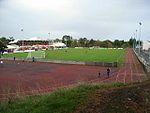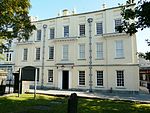Capel Als, Llanelli
Chapels in CarmarthenshireChurches in LlanelliGrade II listed churches in Carmarthenshire

Capel Als is an Independent (Congregational) chapel in Llanelli, Carmarthenshire, Wales, It is regarded as one of the most significant religious buildings in Wales. Folk tradition suggested that the name refers to a woman named Als, which along with Alys is the Welsh equivalent of the English name Alice, whose cottage stood where the chapel was built. Another theory contends that the Welsh word als translates as rock, and there is a rock-face behind the chapel. However, there is no word "als" in Welsh meaning rock, and so this latter explanation may be safely disregarded. It is a Grade II-listed building but many believe it should be accorded more significant status.
Excerpt from the Wikipedia article Capel Als, Llanelli (License: CC BY-SA 3.0, Authors, Images).Capel Als, Llanelli
Avis Terrace,
Geographical coordinates (GPS) Address Nearby Places Show on map
Geographical coordinates (GPS)
| Latitude | Longitude |
|---|---|
| N 51.6817 ° | E -4.1537 ° |
Address
Avis Terrace 1
SA15 1LB , Llanelli
Wales, United Kingdom
Open on Google Maps








